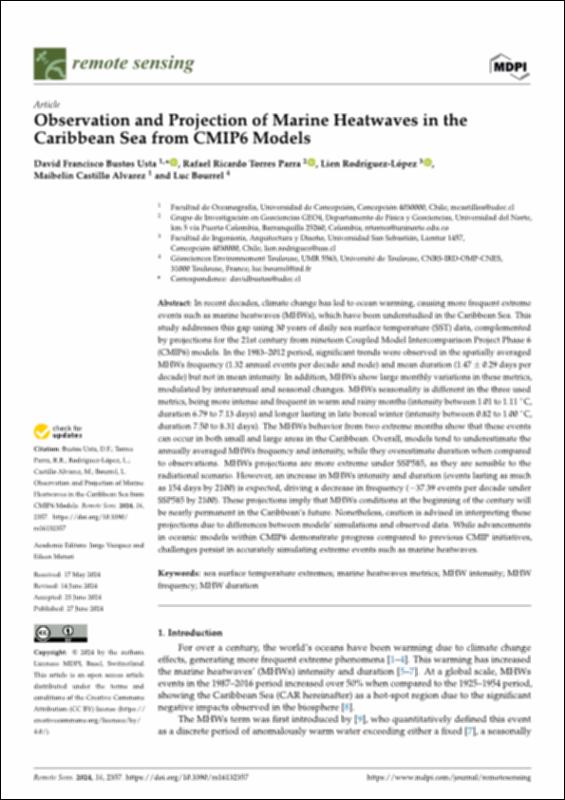- Inicio
- >
- Institucional
- >
- Acceso Abierto USS
- >
- Ver ítem
JavaScript is disabled for your browser. Some features of this site may not work without it.
Descubre información por...
Buscar documentos por...
Mostrar el registro sencillo del ítem
| dc.contributor.author | Rodríguez López, Lien | |
| dc.contributor.author | Bustos Usta, David Francisco | |
| dc.contributor.author | Torres Parra, Rafael Ricardo | |
| dc.contributor.author | Castillo, Maibelin | |
| dc.contributor.author | Bourrel, Luc | |
| dc.date.accessioned | 2024-08-12T14:20:06Z | |
| dc.date.available | 2024-08-12T14:20:06Z | |
| dc.date.issued | 2024-06-27 | |
| dc.identifier.issn | 2072-4292 | |
| dc.identifier.other | Mendeley: 516fd718-9dc5-30de-817d-45333069bd6e | |
| dc.identifier.uri | https://repositorio.uss.cl/handle/uss/8667 | |
| dc.description | Publisher Copyright: © 2024 by the authors. | |
| dc.description.abstract | In recent decades, climate change has led to ocean warming, causing more frequent extreme events such as marine heatwaves (MHWs), which have been understudied in the Caribbean Sea. This study addresses this gap using 30 years of daily sea surface temperature (SST) data, complemented by projections for the 21st century from nineteen Coupled Model Intercomparison Project Phase 6 (CMIP6) models. In the 1983–2012 period, significant trends were observed in the spatially averaged MHWs frequency (1.32 annual events per decade and node) and mean duration (1.47 ± 0.29 days per decade) but not in mean intensity. In addition, MHWs show large monthly variations in these metrics, modulated by interannual and seasonal changes. MHWs seasonality is different in the three used metrics, being more intense and frequent in warm and rainy months (intensity between 1.01 to 1.11 °C, duration 6.79 to 7.13 days) and longer lasting in late boreal winter (intensity between 0.82 to 1.00 °C, duration 7.50 to 8.31 days). The MHWs behavior from two extreme months show that these events can occur in both small and large areas in the Caribbean. Overall, models tend to underestimate the annually averaged MHWs frequency and intensity, while they overestimate duration when compared to observations. MHWs projections are more extreme under SSP585, as they are sensible to the radiational scenario. However, an increase in MHWs intensity and duration (events lasting as much as 154 days by 2100) is expected, driving a decrease in frequency (–37.39 events per decade under SSP585 by 2100). These projections imply that MHWs conditions at the beginning of the century will be nearly permanent in the Caribbean’s future. Nonetheless, caution is advised in interpreting these projections due to differences between models’ simulations and observed data. While advancements in oceanic models within CMIP6 demonstrate progress compared to previous CMIP initiatives, challenges persist in accurately simulating extreme events such as marine heatwaves. | en |
| dc.language.iso | eng | |
| dc.relation.ispartof | vol. 16 Issue: no. 13 Pages: | |
| dc.source | Remote Sensing | |
| dc.title | Observation and Projection of Marine Heatwaves in the Caribbean Sea from CMIP6 Models | en |
| dc.title.alternative | Observación y proyección de olas de calor marinas en el Mar Caribe a partir de modelos CMIP6 | es |
| dc.type | Artículo | |
| dc.identifier.doi | 10.3390/rs16132357 | |
| dc.publisher.department | Facultad de Ingeniería, Arquitectura y Diseño |
Este ítem aparece en la(s) siguiente(s) colección(ones)
-
Acceso Abierto USS [2233]


